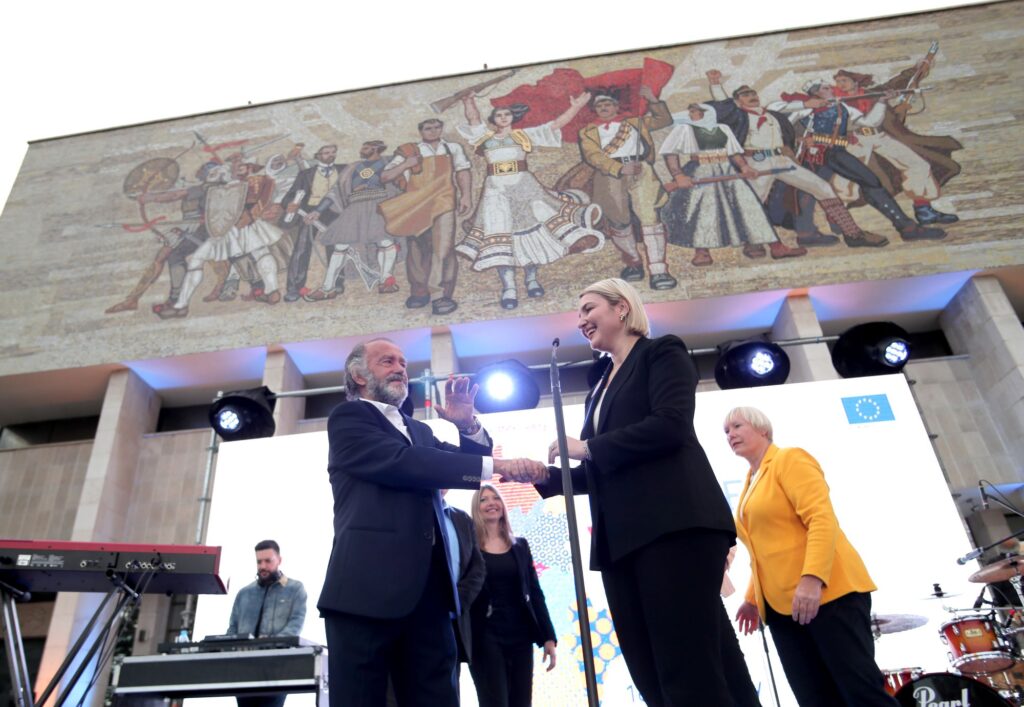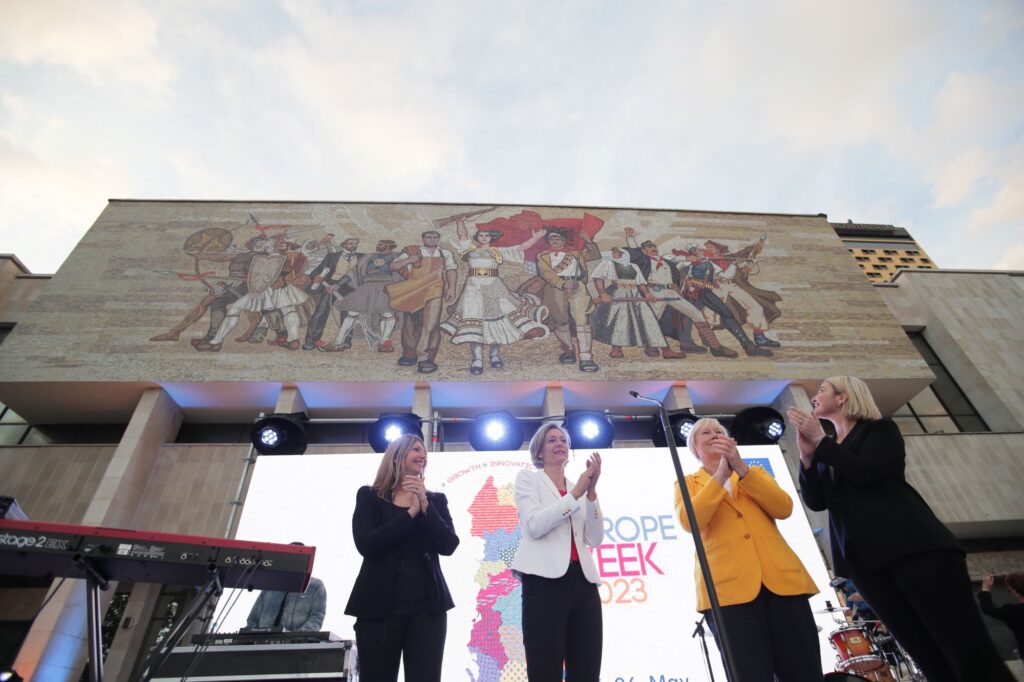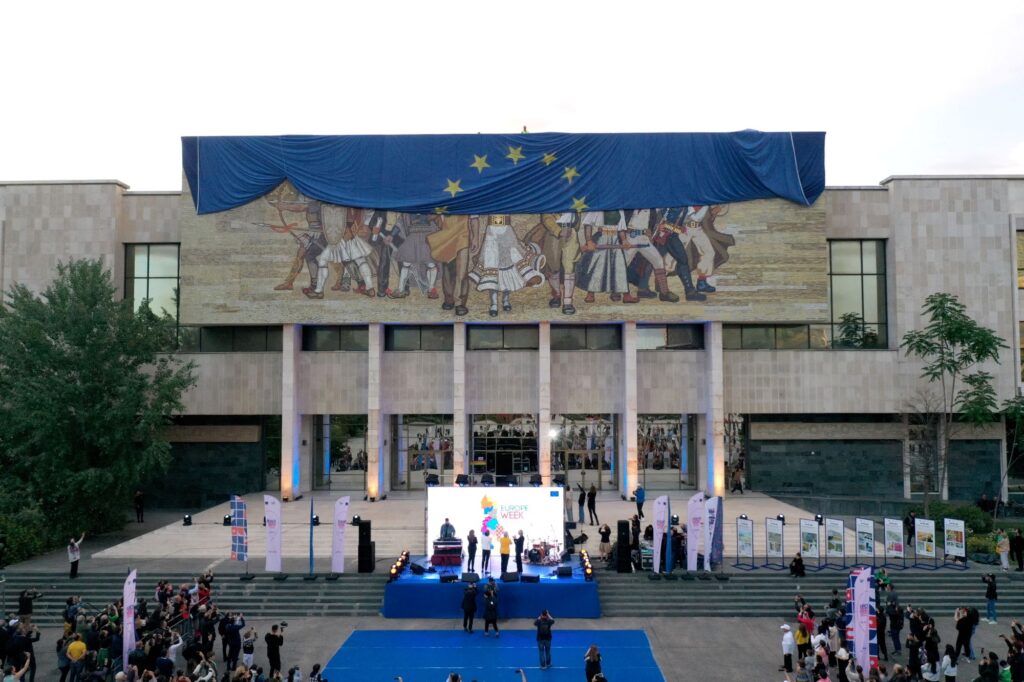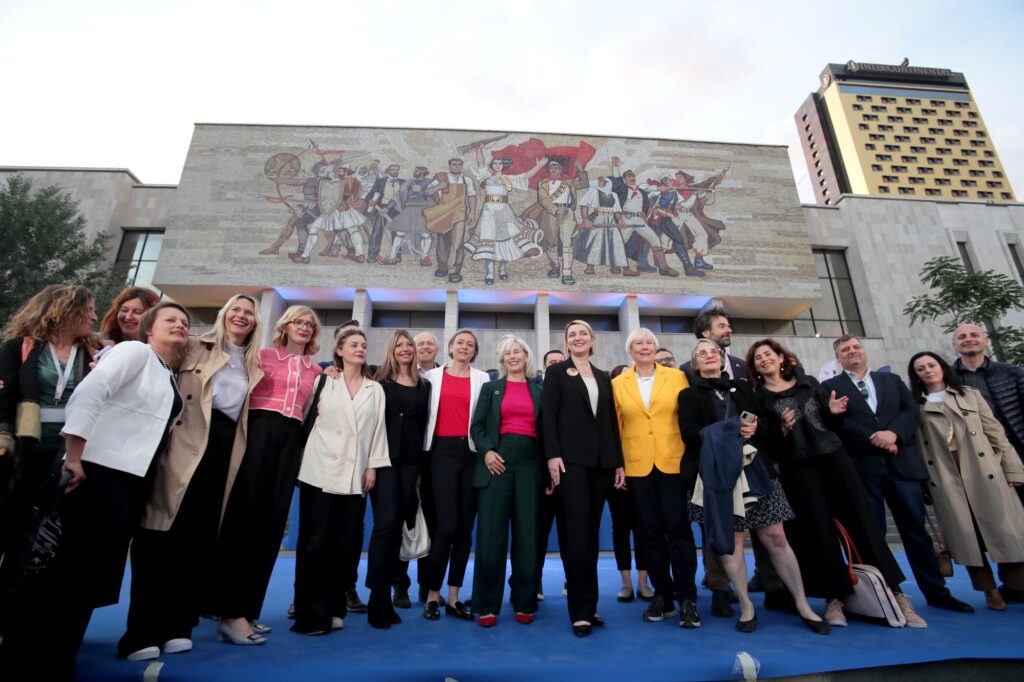Restored Albania’s Iconic Mosaic Regains its Original Shine on Tirana’s Main Square

Tirana, 17 May 2023
Yesterday marked the official unveiling of the restored facade Mosaic at the National Historical Museum in Albania’s Skanderbeg Square. The ceremony was part of the Europe Week celebration and was attended by representatives of the EU Delegation, Ministry of Culture, UN and UNOPS, media, heritage experts, and the creators of the Mosaic. The Mosaic was restored under the EU-funded EU4Culture programme, implemented by the United Nations Office for Project Services (UNOPS) in close partnership with the Ministry of Culture of Albania.
The mosaic of the façade of the National Historical Museum is considered to be one of the finest examples of late Albanian Socialist Realism. Installed in 1981, it showcases, across its 565 m2 surface area, some of the important milestones of the country’s history, spanning from antiquity to the Communist era. Its design was crafted by the renowned artists of the time, including Vilson Kilica, Josif Droboniku, Agim Nebiu, Anastas Kostandini, and Aleksandër Filipi.

In November 2019, Albania was struck by the deadliest earthquake in the past 50 years. Its effects were devastating, causing extensive damage across 11 municipalities, including numerous cultural heritage sites, with the Mosaic being one of them. In response to this crisis, the European Union launched the EU4Culture project, implemented by the United Nations Office for Project Services (UNOPS) in close partnership with the Ministry of Culture of Albania. This project focuses on renovation and revitalization of cultural heritage sites that were damaged by the earthquake, and is one of the largest cultural heritage programs funded by the EU worldwide, with a total budget of €40 million.

“The preservation and restoration of the mosaic has been debatable for many years. There were those who wished to remove it from this façade, however it is easy to demolish the past for the sake of the present, but preserving the memory, of the past with all the good and bad, is vital for any people; a necessary catharsis for the journey to the future.
This restoration is made possible by the EU4Culture programme; a program financed by the European Union and implemented by UNOPS, not only as an aid, but also as a confirmation of the path towards the European family.” – noted Elva Margariti, Minister of Culture of Albania.
“Today is a moment we have been waiting for some time now – the unveiling of the restored mosaic. Thanks to the amazing work of the restaurators and the EU4Culture team, Tirana has back one of its iconic landmarks. We are proud to help Albania preserve its cultural heritage. Today, we are also launching our Europe Week under the motto: Your Skills, Your Future. A talented team of Albanian experts and young students has carefully restored the mosaic. This is exactly what we are doing together: to develop skills for Albania, with the Albanians, to become a full-fledged member of the EU,” EU Ambassador Christiane Hohmann.

“At UNOPS we are extremely proud to be trusted partners of the European Union and Government of Albania in implementing such an important project aimed at bringing back to life the Albanian cultural heritage and creating economic opportunities for local communities.” Freya von Groote, UNOPS Austria Multi Country Office Director.
Background information
In May 2021, EU4Culture assembled a multidisciplinary team of experts, comprising engineers, technologists, conservation and restoration specialists, and the original artists working on the Mosaic in the 1980s, to commence the restoration process. The team embarked on a complex restoration endeavor, facing a variety of challenges. To maintain the integrity of the façade, a free-standing scaffolding was built, reaching 22m in height and not connected to the mosaic in any way. This posed an extraordinary engineering project.

The conservators had to document the 565 m2 mosaic surface area stone-by-stone by hand, using a plastic net and tracing paper. This involved identifying and recording 123 distinct color tones and hundreds of thousands of individual stones (tesserae) at a 1:1 scale. EU4Culture employed a win-win solution by engaging students from the University of Tirana.
Upon further inspection, it was discovered that water leaking through the roof had caused the iron reinforcement bars beneath the surface to rust and expand, forming cavities and fractures in the mosaic. Moreover, some of the original tesserae got discoloured and cracked due to the exposure to moisture and changes in temperature. To remedy the situation, the roof had to be repaired. As a result, more than 437 tons of debris had to be removed and the roof was re-laid with new hydro insulation and leveled to direct rainwater away from the mosaic.

The Mosaic authors assisted EU4Culture team in ordering and purchasing tesseras from the factory based in Venice, Italy, that originally crafted them 40 years ago. Unfortunately, some of the minerals used for producing the original tesserae were no longer available, and chemists and technologists had to identify and create materials that matched the original color tones. The restorers divided the Mosaic into segments and worked on each damaged segment replacing rusted iron bars and tesserae with new ones. The total budget of the works amounted to almost one million EURO (based on the current exchange rate).
The restoration works of the National Historical Museum building and reconceptualization of museum displays are set to continue in the second half of 2023. A new design is being developed through EU4Culture to bring the Museum up to modern international standards. The new modern design will offer visitors an immersive experience to explore the country’s rich heritage and culture.



